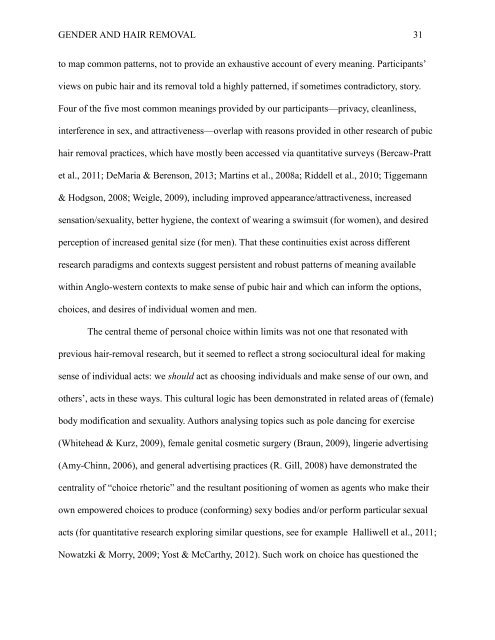Braun, V. , Tricklebank, G. and Clarke, V. (2013) It shouldnt stick out ...
Braun, V. , Tricklebank, G. and Clarke, V. (2013) It shouldnt stick out ...
Braun, V. , Tricklebank, G. and Clarke, V. (2013) It shouldnt stick out ...
Create successful ePaper yourself
Turn your PDF publications into a flip-book with our unique Google optimized e-Paper software.
GENDER AND HAIR REMOVAL 31<br />
to map common patterns, not to provide an exhaustive account of every meaning. Participants’<br />
views on pubic hair <strong>and</strong> its removal told a highly patterned, if sometimes contradictory, story.<br />
Four of the five most common meanings provided by our participants—privacy, cleanliness,<br />
interference in sex, <strong>and</strong> attractiveness—overlap with reasons provided in other research of pubic<br />
hair removal practices, which have mostly been accessed via quantitative surveys (Bercaw-Pratt<br />
et al., 2011; DeMaria & Berenson, <strong>2013</strong>; Martins et al., 2008a; Riddell et al., 2010; Tiggemann<br />
& Hodgson, 2008; Weigle, 2009), including improved appearance/attractiveness, increased<br />
sensation/sexuality, better hygiene, the context of wearing a swimsuit (for women), <strong>and</strong> desired<br />
perception of increased genital size (for men). That these continuities exist across different<br />
research paradigms <strong>and</strong> contexts suggest persistent <strong>and</strong> robust patterns of meaning available<br />
within Anglo-western contexts to make sense of pubic hair <strong>and</strong> which can inform the options,<br />
choices, <strong>and</strong> desires of individual women <strong>and</strong> men.<br />
The central theme of personal choice within limits was not one that resonated with<br />
previous hair-removal research, but it seemed to reflect a strong sociocultural ideal for making<br />
sense of individual acts: we should act as choosing individuals <strong>and</strong> make sense of our own, <strong>and</strong><br />
others’, acts in these ways. This cultural logic has been demonstrated in related areas of (female)<br />
body modification <strong>and</strong> sexuality. Authors analysing topics such as pole dancing for exercise<br />
(Whitehead & Kurz, 2009), female genital cosmetic surgery (<strong>Braun</strong>, 2009), lingerie advertising<br />
(Amy-Chinn, 2006), <strong>and</strong> general advertising practices (R. Gill, 2008) have demonstrated the<br />
centrality of “choice rhetoric” <strong>and</strong> the resultant positioning of women as agents who make their<br />
own empowered choices to produce (conforming) sexy bodies <strong>and</strong>/or perform particular sexual<br />
acts (for quantitative research exploring similar questions, see for example Halliwell et al., 2011;<br />
Nowatzki & Morry, 2009; Yost & McCarthy, 2012). Such work on choice has questioned the

















